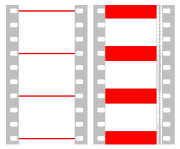
Frame line
Encyclopedia

Film frame
In filmmaking, video production, animation, and related fields, a film frame or video frame is one of the many still images which compose the complete moving picture...
s, on the release print
Release print
A release print is a copy of a film that is sent to a movie theater for exhibition.-Definitions:Release prints are not to be confused with the other types of print used in the photochemical post-production process:...
of a motion picture
Film
A film, also called a movie or motion picture, is a series of still or moving images. It is produced by recording photographic images with cameras, or by creating images using animation techniques or visual effects...
. They can vary in width; a 35 mm film
35 mm film
35 mm film is the film gauge most commonly used for chemical still photography and motion pictures. The name of the gauge refers to the width of the photographic film, which consists of strips 35 millimeters in width...
with a 1.85:1
Aspect ratio (image)
The aspect ratio of an image is the ratio of the width of the image to its height, expressed as two numbers separated by a colon. That is, for an x:y aspect ratio, no matter how big or small the image is, if the width is divided into x units of equal length and the height is measured using this...
hard matte has a frame line approximately 8 millimeters (0.3 inches) high, whereas both a full frame
Full frame
In cinematography, full frame refers to the use of the full film gate at maximum width and height for 35 mm film cameras. It is sometimes also referred to as silent aperture, full gate, or a number of other similar word combinations. It is the original gate size pioneered by William Dickson and...
negative and the anamorphic format
Anamorphic format
Anamorphic format is a term that can be used either for: the cinematography technique of capturing a widescreen picture on standard 35 mm film, or other visual recording media, with a non-widescreen native aspect ratio; or a photographic projection format in which the original image requires an...
have very narrow frame lines, with the frames very close together. When a film is properly projected, the frame lines should not be visible to the audience and are typically cropped out in projection
Movie projector
A movie projector is an opto-mechanical device for displaying moving pictures by projecting them on a projection screen. Most of the optical and mechanical elements, except for the illumination and sound devices, are present in movie cameras.-Physiology:...
with an aperture mask.

